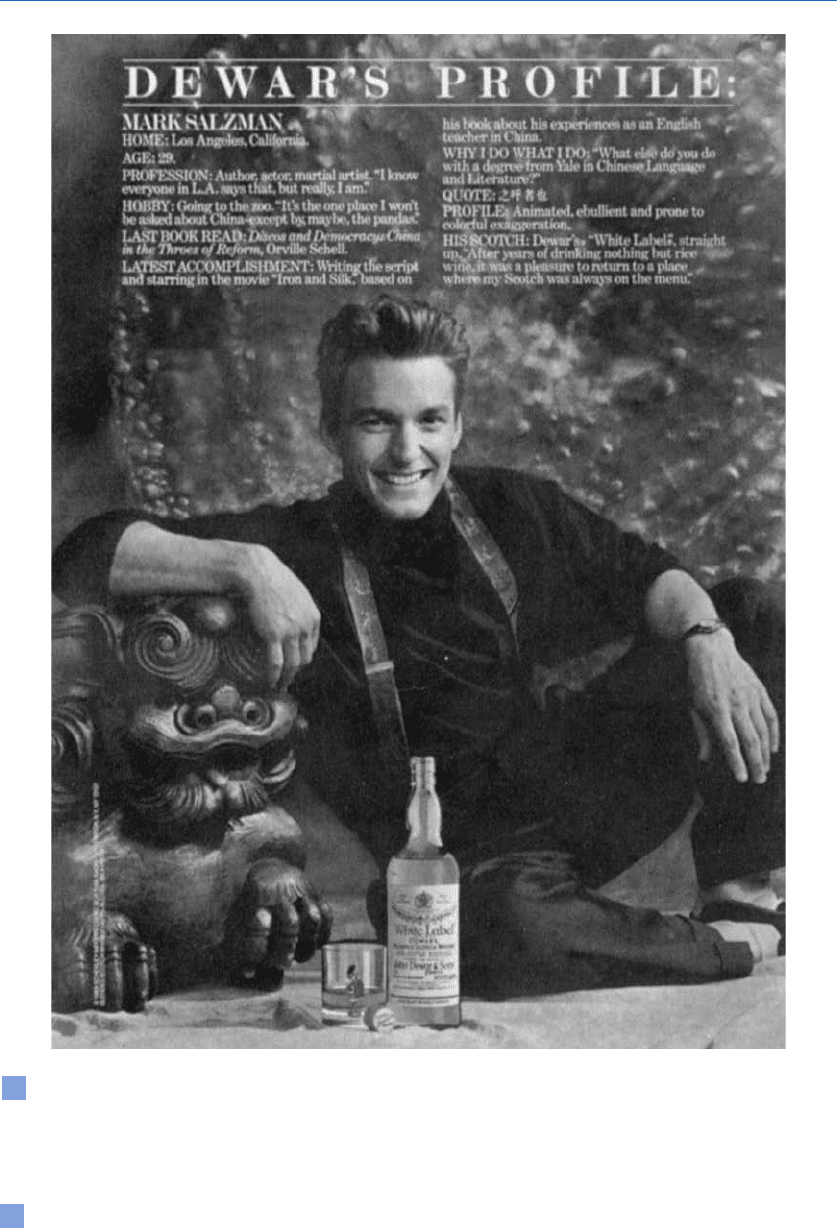Onkvisit S., Shaw J. International Marketing: Analysis and Strategy
Подождите немного. Документ загружается.


456
ADVERTISING
Figure 15.4 A standardized advertisement?
Source:
Reprinted with permission of Schenley Industries, Inc.

advertisement featured a Bangkok architect. These
campaigns were handled by the local Leo Burnett
offices.
22
Because of the inclusion of both the stan-
dardization and localization elements, it is very dif-
ficult to determine whether these campaigns are
more standardized than localized (or vice versa) –
without a precise definition of the concept of
standardization.
The issue of advertising standardization, without
doubt, has far-reaching implications. If it is a valid
strategy, international business managers should
definitely take advantage of the accompanying ben-
efits of decision simplification, cost reduction, and
efficiency. On the other hand, if the premise of this
approach is false, the indiscriminate application of
standardized advertising in the marketplace will
cause more harm than good since it may result in
consumers misinterpreting the intended message.
Consequently, the important function of advertising
to facilitate a consumer’s search process can be
seriously impaired.
Three schools of thought
There are three schools of thought on the issue of
standardized advertising: (1) standardization, (2)
individualization, and (3) compromise.
23
The stan-
dardization school, also known as the universal,inter-
nationalized, common, or uniform approach, questions
the traditional belief in the heterogeneity of the
market and the importance of the localized
approach.This school of thought assumes that better
and faster communication has forged a convergence
of art, literature, media availability, tastes, thoughts,
religious beliefs, culture, living conditions, lan-
guage, and therefore advertising. Even when people
are different, their basic physiological and psycho-
logical needs are still presumed to remain the same.
Therefore, success in advertising depends on moti-
vation patterns rather than on geography. British
Airways’ image advertisements featuring movie
stars, which were designed by Saatchi and Saatchi
in the 1970s to trumpet the newly sleek British
Airways, have been cited as an example of a suc-
cessful standardized campaign.
The opposite views of the standardization school
is the localization school, also known as the non-
standardization, specificity, individualization, adapta-
tion, or customization approach. This conventional
school of thought holds that advertisers must
particularly make note of the differences among
countries (e.g., culture, taste, media, discretionary
income). These differences make it necessary to
develop specific advertising programs to achieve
impact in the local markets. A good illustration of
the importance of localization is the Shiseido case.
The Japanese corporation, the world’s third largest
cosmetic company, did poorly in its first attempt to
penetrate the US market because its advertisements
featured only Japanese models.
Between these two extreme schools is the
compromise school of thought. While recognizing
local differences and cautioning against a wholesale
or automatic use of standardization, this middle-of-
the-road school holds that it may be possible, and in
certain cases even desirable, to use US marketing
techniques everywhere under some conditions.
Jain has proposed a framework for determining
marketing program standardization. Standardiza-
tion is more practical and effective under these
conditons.
24
1 Markets are economically alike.
2 Worldwide customers, not countries, are the
basis for identifying the segments to serve.
3 Countries have similar customer behavior and
lifestyle.
4 The product has cultural compatibility across
countries.
5 There is a great degree of similarity in a firm’s
competitive position in different markets.
6 The firm competes against the same adver-
saries with similar share positions in different
markets.
7 Product is industrial or high-tech (versus con-
sumer product).
8 Home market-positioning strategy is meaning-
ful in the host market.
9 Countries have similar physical, political, and
legal environments.
1111
2
3
4
5
6
7
8
9
10111
1
2
3
4
5
6
7
8
9
20111
1
2
3
4
5
6
7
8
9
30
1
2
3
4
5
6
7
8
9
40
41
42
43
44
45111
457
ADVERTISING

10 There are similar marketing infrastructures in
the home and host countries.
11 Firms possess key managers who share a
common world view.
12 Strategic consensus exists among parent–sub-
sidiary managers.
13 Authority for setting policies and allocating
resources is centralized.
Keegan provides a set of guidelines that can help
in determining when it is appropriate to use stan-
dardized advertising.According to Keegan,there are
five international product and promotion strate-
gies.
25
The choice of strategy depends on such
factors as cost, need, and use conditions.A particu-
lar product may be extended (i.e., unchanged) if use
conditions are uniform across markets. Likewise,
a promotional campaign may be standardized or
extended if consumer need for this particular
product is universal. As a company moves from the
first strategy toward the last, there is a correspond-
ing increase in cost.
The first of the five strategies is one product, one
message,worldwide.This strategy is feasible if both the
need and use conditions are uniform across coun-
tries. Not many products satisfy these conditions,
though Coke and Pepsi are often cited as examples.
Other examples include diamonds, Chivas Regal
Scotch, and BMW automobiles. Mentioned in jest
by some authorities are products that may be even
more truly global, such as Israeli Uzi submachine-
guns, French Exocet missiles, Russian Kalashnikov
rifles, and nuclear weapons.
The second of the five strategies is product exten-
sion-communications adaptation. A product may be
extended to other countries because of uniform
use conditions, but the promotional message will
probably need to be changed since needs vary.
Toothpaste is used in the same manner everywhere
but often for different reasons. People in the north
of England and the French-speaking areas of Canada
use toothpaste primarily for breath control, making
the appeal of fluoride toothpastes rather limited.
Anheuser-Busch and its partners market the
same beer in many countries but customize their
advertisements (based on American themes) for
each national market.
Product adaptation-communications extension is the
third strategy.When use conditions differ but need
remains constant across markets, modification of
product but not promotion is necessary. Black and
Decker, although wanting to globalize its power
tools, must make several product adjustments to fit
certain markets. The tools everywhere look the
same on the outside, but inside it is another matter,
especially for markets in which the variations in
electrical outlets and voltages require different
circuits and cords.
Dual adaptation is the fourth strategy. Both the
product and the promotion have to be changed
for a foreign market owing to variations in need
as well as use conditions in different countries.
Refrigerators made for the USA, for example, must
be modified to accommodate 220-volt and 50-Hz
electricity overseas. The large refrigerator and its
spacious freezer compartment do not appeal to
people in countries where shopping for fresh food
is done daily and where a refrigerator is used mainly
for short-term storage. In addition, with the high
cost of electricity in virtually all markets outside
the USA, the advertising appeal must be based on
low electricity consumption, durability, reliability,
and compactness.
Product invention is the last strategy.This strategy
may have to be used if the existing product is too
expensive for foreign consumers. A brand new
product with different features may have to be
designed in order to make it affordable. For genera-
tions, Indians have called dhobis to collect dirty laun-
dry from middle-class neighborhoods and wash it
upon the rocks in the rivers.Seeing this as an oppor-
tunity for product invention, Whirlpool Corp. has
appealed to young professional Indian couples who
want Western-style automatic washing machines by
offering what it calls the World Washer.Whirlpool’s
compact washers have specially designed agitators
that do not tangle saris, the flowing outfits worn by
a large number of Indian women.Variations of the
World Washer are also manufactured and sold in
Brazil and Mexico, and there are plans to export
458
ADVERTISING

them to other Asian and Latin American countries.
Apart from minor variations in the controls, the
three versions are nearly identical and sell for $270
to $650.The World Washer is a simple, affordable,
bare-bones washer that does only eleven pounds
of washing, or about half the capacity of the typical
US model.
26
Keegan’s guidelines, although useful, are quite
general. Thus one must consider other relevant
factors and treat them explicitly.
Feasibility and desirability
For an international advertising manager, the deci-
sion is affected by his or her perception of whether
it is “feasible” and “desirable” to implement stan-
dardization. In some cases it may be feasible but not
desirable to use a standardized advertisement; in
other cases it may be desirable but not feasible to do
so.The applicability of advertising standardization is
a function of these two conditions.
The feasibility issue has to do with whether
environmental restrictions or difficulties may pro-
hibit the use of a standardized campaign. Three
common problems are literacy (for print advertise-
ments), local regulations, and media and agency avail-
ability.
Because illiteracy adversely affects the compre-
hension of advertising copy, the text portion of an
advertisement must frequently be minimized or
replaced with pictures. Visual aspects influence
perceived similarity of advertising.
27
Nevertheless,
not all types of pictures are universal in their mean-
ings, and some may not be an effective means of
communicating with nonliterate market segments.
Therefore, although pictures are more universal
than words, international marketers should still
research their markets before attempting to com-
municate with them through pictures.
Many countries have laws that place restrictions
on the nature, content, and style of advertising mes-
sages.The Marlboro cowboy was banned in England
on the grounds that cowboy worship among chil-
dren might induce them to take up smoking. So the
company had to use noncowboys driving around
Marlboro country in a Jeep.
Germany’s emphasis on fair competition results
in the prohibition of slander against competitors.
As a result, the advertiser must be wary of using
comparatives (e.g., better, superior) and superla-
tives (e.g., best, most durable). In China, Duracell
battery commercials were taken off the air because
the drumming bunny’s endurance claim violated the
rules that prohibit superlative claims and compara-
tive advertising. Likewise, Budweiser’s “King of
Beers” slogan was found to be unacceptable.
A multinational advertiser wishing to use a stan-
dardized advertising campaign needs to rely on an
advertising agency with a worldwide network to
coordinate the campaign across nations. Unfortu-
nately, almost no agencies, regardless of size, are
in a position to control local agencies overseas. In
spite of this difficulty, a few multinationals (e.g.,
Bayer, Colgate-Palmolive) have decided to consoli-
date their global advertising at one agency. Ogilvy
& Mather Worldwide, overseeing 272 offices,
created “White on White” TV commercials to sell
laundry detergent in France and was later used to
replace twenty different local campaigns in thirty
countries. Similarly, IBM’s Personal Systems Group
awarded its entire sales promotion business to
Einson Freeman Promotional Campaigns, making it
the first global brand to use a single agency.
It should be noted that the use of a single agency
to handle worldwide advertising, while resembling
the standardization approach, does not necessarily
mean that the approach is purely standardization.
While Colgate-Palmolive believes that there is no
need to reinvent a winning formula, the directive
of IBM’s Personal Systems Group is “Do it once,
replicate, and localize.”
According to one study, advertising agency exec-
utives believe that client pressure will result in
greater use of standardization. However, they also
feel that client pressure and “saving money” are
among the least important reasons for standardiza-
tion because it makes no sense to use a bad or
unproven campaign just to save money. Local agen-
cies tend to think that they can produce better
advertisements for their local markets and that cre-
ative impact should be the most important reason
1111
2
3
4
5
6
7
8
9
10111
1
2
3
4
5
6
7
8
9
20111
1
2
3
4
5
6
7
8
9
30
1
2
3
4
5
6
7
8
9
40
41
42
43
44
45111
459
ADVERTISING

as to whether an advertisement should be standard-
ized or localized.
28
A study of ethical perceptions provides another
relevant perspective. Relative to the USA, hiring
personnel from other advertising agencies was
viewed more negatively in Korea. Also in Korea,
clients’ expectations for favors as well as social
obligations arising from gifts received may require
a different response.
29
Degree of feasibility varies from country to
country, facilitating the implementation of stan-
dardization in some countries while creating prob-
lems in others. Furthermore, an environment may
change, permitting either more or less opportunity
for standardization in the future. Therefore, feasi-
bility is dependent on the situation and does not
offer solid support for either of the two extreme
schools of thought.
Three major criteria exist to judge the degree of
desirability of a standardized advertisement. One
of these is the amount of cost savings that may be
achieved. Thus standardization is desirable only
when the derived saving in production cost of this
type of advertisement is significant.
Another criterion of desirability is consumer
homogeneity, a major assumption of the uniform
approach. If consumers were indeed homogeneous
across countries, the debate would be resolved,
since consumers could then be motivated in exactly
the same way. Are consumers homogeneous? The
proponents of each school of thought have offered
real-life examples that are subjective and highly
judgmental. Consumers would be better served
if the collection of empirical data were based on
research designs that eliminate the effect of con-
founding factors.The results of the literature review
of management responses, consumer characteris-
tics, and consumer responses indicate that there is
no theoretical or empirical evidence to support the
standardization perspective in its present form.
30
As
an example, a sample of Dutch respondents exhib-
ited a somewhat negative attitude toward the use of
the English language in TV commercials.When the
English text was shown on the screen as well as spo-
ken,about 50 percent of the subjects made a correct
interpretation. Without the text being shown, the
percentage dropped to just 22 percent. Therefore,
the use of a foreign language (English in this case)
made it more likely for a commercial to be misun-
derstood.
31
Language thus poses a challenge.
The third criterion of desirability has to do with
the degree of cooperation of an MNC’s foreign sub-
sidiaries and national managers. Because of sub-
sidiaries’ involvement,it is a good idea to investigate
the standardization decision-making process by
studying two organizational factors (decision
powers of subsidiaries and familiarity with foreign
markets at headquarters) and two cultural factors
(similarity in market position and country environ-
mental conditions). MNCs are more likely to cen-
tralize control and adopt standardization when they
understand similarities in market position, when
460
ADVERTISING
Cadbury ran an advertisement in a Mumbai newspa-
per. The advertisement featured a map highlighting
the boundaries of India’s Jammu–Kashmir state, the
Indian-controlled part of a disputed region. The
company compared the Kashmir region to a chocolate
that was too good to share. The copy below the map
read: “Issued in the spirit of Independence Day by
Cadbury Temptations – International chocolates you’d
love to share but won’t.” India and Pakistan have
fought two wars over the province. Cadbury was
rebuked for using a highly sensitive issue as a topic
for advertising. After all, the dispute has claimed the
lives of thousands of people and soldiers.The company
apologized. In hindsight, both Cadbury and its adver-
tising agency should have known better.
Source:
“Cadbury Apologizes for India Ad,”
San José
Mercury News
, August 23, 2002.
MARKETING ETHICS 15.1 NOT A LAUGHING MATTER

they are familiar with foreign contexts, and when
they develop shared values and beliefs among sub-
sidiary managers and headquarters managers.
Otherwise, standardized decisions are likely to be
challenged by local subsidiaries.
32
Similarly, another
study confirmed that a global company’s ability to
foster successful relationships in terms of marketing
operations between the headquarters and its foreign
subsidiaries can enhance product performance
across markets. As a firm tries to standardize its
marketing programs, the subsidiaries’ acquiescence
becomes increasingly important.
33
Research and empirical evidence
At present, the research focus has shifted toward a
more limited level of horizontal homogeneity. Instead
of showing that multiple countries are basically
equivalent (when it is now quite clear that they are
not), several researchers have moved away from the
country as a unit of analysis. Instead, they focus on
examining whether a subset of one national market
is similar to another subset of another national
market. This is what Hassan and Blackwell and
Unnava et al. call a global segment.
34
A recent study focused on “marketing universals”
which are defined as “consumer behaviors within a
segment and toward a particular product category
that are invariant across cultures.” The researchers
used a sample representing thirty-eight nationalities
and found that, while certain behaviors are likely to
be universal, others are not. Therefore, marketing
strategies should not be uniform across countries.
35
At present, the available empirical data deal with
the effectiveness of standardization only in an indi-
rect manner. The available data are concerned
primarily with showing how national markets differ
in some ways without indicating whether such
differences actually affect the effectiveness of inter-
national standardization. Most of the recent studies
have shifted the emphasis to national advertising prac-
tices. The evidence is rather overwhelming that
certain advertising methods (e.g., use of symbols,
comparative advertising) may be the norm in
some countries but the exception in others. The
researchers are virtually unanimous in cautioning
against the automatic use of standardization.Accord-
ing to them, since consumers are used to a certain
advertising method which is predominant in their
country, these consumers may not be receptive to
other advertising tactics.
36
One group of researchers has focused on corporate
responses by investigating whether multinational
firms prefer to standardize or localize their cam-
paigns. Overall, companies are more likely to
employ localization rather than standardization, and
advertising in particular is the component of the
marketing mix that is most adapted. However, a
recent interview with 150 Norwegian exporters,
focusing on standardization and cooperative climate,
found that companies with high local market know-
ledge had better performance.While the researcher
believed that this relationship partially supported
the standardization approach, it should be noted that
standardization usually focuses on the home country
while ignoring the preference of the host countries.
As also noted by the author, standardization pro-
grams should not be initiated without a thorough
understanding of local market conditions.
37
Examinations of advertisement content have
repeatedly found that, in practice, the content or
message of advertisements varies significantly from
one market to another. In the case of children’s TV
commercials from China and the USA, a content
analysis found that Chinese commercials reflect
China’s traditional cultural values and its social and
economic development level. However, there
appears to be a shift in China from the elderly to
the young, reflecting the country’s one-child policy.
There is also some evidence of Western values
creeping in.
38
Another study compared the US and
Chinese advertising appeals in terms of cultural
values. The youth/modernity appeal, supposedly
reflecting Westernization, is equally and promi-
nently displayed in both sets of commercials.Yet the
Chinese commercials emphasize the following cul-
tural values more frequently: (1) the soft-sell appeal
in seven product categories, (2) the veneration
elderly/tradition appeal in six product categories,
(3) the oneness with nature appeal in two product
1111
2
3
4
5
6
7
8
9
10111
1
2
3
4
5
6
7
8
9
20111
1
2
3
4
5
6
7
8
9
30
1
2
3
4
5
6
7
8
9
40
41
42
43
44
45111
461
ADVERTISING

categories, and (4) the group consensus and status
appeals each in one product category. In contrast,
the US advertisements more frequently use the
hard-sell appeal, the time-oriented and individ-
ual/independence appeals, and the product merit.
39
Japanese advertisements are also distinct. A
content analysis of how teenage girls and “girlish”
images were portrayed in eight issues of Seventeen
magazine (four being the US edition and four being
the Japanese version) found culture-based differ-
ences. There is a higher frequency of verbal and
visual girlish images in the Japanese issues.
40
An
analysis of women’s magazine advertisements in
Germany and Japan focused on ad format, use of
models, male and female role portrayal, and value
appeals. While there are some similarities, there
are also distinct cross-national differences in the
way marketers adapt their strategies.The nontradi-
tional approaches in targeting women are more
culturally specific than the traditional approaches.
Male role portrayal is an important element of the
non-traditional approaches in women’s maga-
zines.
41
Similarly, a study of TV commercials from
Japan, Russia, Sweden, and the USA in terms of
the masculine–feminine continuum found that fem-
inine countries show a higher degree of emphasis
on relationships for male and female characters.
Since not all cultures share the same values, adver-
tising standardization appears to be strategically
unwise.
42
One content analysis examined advertisements
from the USA, Egypt, Lebanon, and the United
Arab Emirates. In Arabic magazine advertisements,
people are depicted less frequently. When these
advertisements show women, the women wear long
dresses. The American advertisements, in contrast,
provide more information content, price informa-
tion, and comparative advertising.
43
Yet another
content analysis found that standardization is a
flexible policy that may be adapted to accommodate
different market circumstances.
44
While Hollywood movies are an international
medium, the acceptance of these movies as well as
products placed in them may vary from one country
to another. Unlike commercials that can be adapted
for a particular country, product placement is not
so adaptable because a movie shows a product
being placed in the same way all over the world.
Consumers in the USA, France, and Austria exhib-
ited varying responses with regard to acceptability
and purchase behavior. As an example, Americans
were more likely to accept and purchase the prod-
ucts shown in the movies. However, there was also
some degree of convergence. For example, women
were less positive than men, and this less positive
attitude was persistent across all three countries. In
any case, one implication is that it is a good idea
to identify specific segments in terms of country,
product, and individual differences.
45
In practice, the degree of standardization
depends in part on corporate policy and strategic
planning.At the same time, it depends on the impor-
tance of a particular overseas market and the insis-
tence of the head of that subsidiary. As in the case
of Harley-Davidson, the corporate headquarters
had always required the Japanese to use the US
print advertisements.
46
But the president of the
Japanese unit felt that desolate scenes and the tag
line “one steady constant in an increasingly screwed-
up world” were not meaningful to Japanese buyers.
He was finally able to obtain permission in to run
a separate advertising campaign. The advertise-
ments juxtaposed American images with traditional
Japanese ones (e.g.,American riders passing a geisha
in a rickshaw). While it is difficult to determine
the effect of the new campaign on sales, the waiting
lists for Harley-Davidson motorcycles have grown
longer.
After having seen or experienced difficulties in
implementing the standardization concept, most
international advertisers today have had second
thoughts about standardization and have moved
toward some degree of localization. Parker Pen Co.
launched an ambitious “one world, one voice” pro-
gram in 1984 to sell its writing instruments all over
the world.The campaign was a big disappointment,
and the company has once again tailored its adver-
tisements to local markets. As Procter & Gamble’s
international chief has pointed out, although “tech-
nology” (e.g., gel toothpaste) is global, other aspects
462
ADVERTISING

such as taste, coloring, packaging, and advertising of
the technology are usually local.
In conclusion, an overwhelming number of
studies does not show evidence that supports stan-
dardization. Instead, most studies have found con-
sumer, market, and media differences. However, the
empirical evidence that contradicts the use of stan-
dardization is indirect in nature.This is not surpris-
ing because it is very difficult to design a study that
truly proves the validity (or lack of it) of advertis-
ing standardization. It is possible though to design a
more rigorous study that will address the issue in
terms of cause and effect.
47
A decision-making framework
All forms of advertising standardization should not
be ignored by the marketer.This technique may be
appropriate on a modest scale, though definitely not
on a worldwide basis. A limited homogeneity does
existing in many cultures around the world.Thus it
is a good idea to find out when and where this
limited scale of homogeneity exists so that some
level of standardization may be considered.
For decision-making purposes, market segmen-
tation can provide a practical framework for stan-
dardizing advertising, as shown in Figure 15.5. If the
world is treated as one whole market, a standard-
ized advertisement may then be used. But if the
world is divided into several segments (i.e., regions
or countries), each segment probably requires its
own custom-made marketing mix (i.e., a localized
advertisement).
A market should be segmented when five
requirements are met: identification, accessibility,
differential response, segment size, and cost/profit.
Each country (or region) should be considered as
a distinct segment if the following conditions
are met:
1 The marketer can identify the country’s unique
demographic characteristics.
2 The responses to a unique marketing mix of
customers in the country will be appreciably
different from those of other countries.
3 The country is accessible through available
selective advertising media with minimum pro-
motion waste.
4 The country’s population size is large enough
to justify the specially designed marketing cam-
paign.
5 Incremental cost as a result of the segmentation
is less than incremental profit.
When all these segmentation criteria are met,
market segmentation is applicable but advertising
standardization is not. There is no question that
the USA is a market segment on its own due to
its unique characteristics and responses, media
availability, market size, and great profit potential.
As such, Asian and European marketers generally
design advertisements specifically for the US
market. In contrast, these marketers are more likely
to introduce in, say, Asian countries (except Japan)
the advertisements that they have already used in
their own countries.This action may be due to their
belief that these other markets are either similar or
are not economically significant enough to justify
nonstandardized advertising.
In a number of cases, it may not be strategically
sound to localize an advertisement for a particular
market. Some countries are too small to warrant
that kind of special attention and the associated
cost. From 1870 to the 1920s, as tariff rates slowly
rose, the number of nations remained stable or
decreased. When trade barriers fell dramatically
after World War II, the number of small countries
soared from seventy-four in 1946 to 192 in 1995.
At present, over half of all nations have smaller pop-
ulations than the state of Massachusetts.
48
It is
almost impossible to justify why an international
firm should design an advertisement specifically
for Tuvalu, whose economy relies on fishing and
coconuts, and has a population of only 10,000.
49
Even on a bigger scale, it may be easier to justify
why, in many instances, standardization should not
be employed when marketing in the CIS countries.
In spite of their new-found independence, they are
still similar in many ways. Perhaps more impor-
tantly, their market sizes may not be adequate:
1111
2
3
4
5
6
7
8
9
10111
1
2
3
4
5
6
7
8
9
20111
1
2
3
4
5
6
7
8
9
30
1
2
3
4
5
6
7
8
9
40
41
42
43
44
45111
463
ADVERTISING

Armenia (3.8 million citizens), Azerbaijan (8.1
million), Georgia (5.4 million), Kazakhstan (14.9
million), Kyrgyzstan (4.7 million), Tajikistan
(6.2 million), Turkmenistan (5.4 million), and
Uzbekistan (25 million).
50
Marketers should understand that standardiza-
tion is not a universal tool that can be automatically
used without proper consideration. It makes no
sense to forge worldwide uniformity and confor-
mity for management’s convenience if consumers
seek diversity and individuality. Standardization and
advertising are not synonymous. Advertising is sup-
posed to (1) inform and (2) persuade customers (3)
effectively. Standardization may fail to perform any
(or all) of these three objectives.Thus it is critical
to pretest each advertisement in an international
context to determine the effectiveness in terms of
attention getting, comprehension, and persuasion.
It is probably a mistake to use either standard-
ization or localization on a wholesale basis. Some
degree of standardization or localization on an
international or regional basis should be carefully
464
ADVERTISING
Criterion 1: Identification
Does the target group have unique and
measurable characteristics?
Criterion 2: Selectivity
Can this group be reached through the
available media with minimum waste?
Criterion 3: Response
Will this group respond differently but
more favorably than other groups to this
particular marketing mix (e.g., a
specially prepared advertisement)?
Criterion 4: Size
Is the group significant enough in terms
of size to justify a special attention?
Criterion 5: Cost/Profit
Market segmentation
Will extra costs associated with the
special attention to the group be less
than incremental profit?
Localization
(nonstandardization)
yes
yes
yes
yes
yes
yes
no
Standardization
no
Standardization
no
Standardization
no
Standardization
no
Standardization
Figure 15.5 A decision-making framework for advertising standardization
Source:
San Onkvisit and John J. Shaw, “Standard International Advertising: A Review and Critical Evaluation of the
Theoretical and Empirical Evidence,”
Columbia Journal of World Business
22 (fall 1987): 53.

considered. While a US campaign may not work
well in Europe, some type of pan-European adver-
tising may be possible.Yet even then, some country-
specific information may still be required. It is
important to realize that a well-thought-out adver-
tising idea tends to perform reasonably well in mul-
tiple markets without a great deal of adjustment,
but any flaws associated with a standardized adver-
tisement will multiply in tandem with the number
of countries. As advised by McCollum Spielman,
Worldwide’s chief executive officer, “the best
precept to follow is to do your homework. When
entering another country, make sure that your ad
campaign meets the basic rules and preconditions of
its targeted culture. Test it! And be sure to test
through a researcher who is part of that culture.”
51
GLOBAL ADVERTISING: TRUE
GEOCENTRICITY
Criticisms of myopic standardization should not be
interpreted as an endorsement for a polycentric
approach, which requires custom-made campaigns
for each individual market. Localization, practiced
for its own sake, can be just as myopic. What is
desirable is a kind of geocentricity, which is not the
same thing as standardization.
Standardization is basically a campaign designed
for one market (home country) but exported to
other markets regardless of justification. In contrast,
a geocentric campaign requires an advertisement to
be designed for the worldwide audience from the
outset in order to appeal to shared common denom-
inators while allowing for some modification to suit
each market.The geocentric approach combines the
best of both worlds (i.e., the cost-reduction advan-
tage of standardization and the advantages of local
relevance and effective appeal of individualization).
For example, Levi Strauss has switched from all
localized advertisements to a pattern advertising
strategy that provides the broad outlines,but not the
details, of the campaign.
Devising a global advertisement is anything but
easy. However, with some planning, it is possible
to create an advertisement which can maintain the
main theme internationally while allowing neces-
sary adaptation. A global advertisement should be
adaptation-ready in the sense that necessary and
desirable adaptation is planned at the time of con-
ception rather than after the fact. Coca-Cola Co.’s
“General Assembly” campaign is a good example.
The campaign shows a thousand children singing the
praises of Coke. Because each McCann office had
permission to edit the film to include close-ups of
a youngster from its market, at least twenty-one
different versions of the spot existed.
52
The success of IBM’s Subtitles campaign has
demonstrated that it is possible to integrate global
and local action if the markets are similar and if
the product/brand is perceived similarly in those
markets. Previously, the company allowed each of
its core thirteen semiautonomous business entities
to develop its own independent business strategy.
Seeing greatness in the sum of the parts, IBM’s
chairman reintegrated these units into a cohesive
whole in 1993. One advertising agency was
appointed in 1994 to have the prime responsibility
for executing IBM’s communication programs with
a single voice worldwide.
The Subtitles campaign achieved global imagery
through the use of the same footage in each country
while employing local subtitles to translate the for-
eign language of the commercial. Local subtitling
permits each country to retain its home cultural
accent.The message of the campaign was that IBM
could deliver simple and yet powerful solutions
to manage information anywhere and any time for
individuals and companies of all sizes.The company
wanted to communicate that it was vigorous and
innovative while maintaining the latent strengths of
global scope, leadership, and reliability. Naturally,
the international implementation encountered
some local difficulties ranging from limited access to
television commercials to the common practice of
dubbing for foreign language films and commercials.
The campaign was run in forty-seven countries,
and was pretested and/or tracked in over twenty
markets worldwide. Although individual markets
showed some response variation, the responses to
the campaign were considerably consistent.Among
1111
2
3
4
5
6
7
8
9
10111
1
2
3
4
5
6
7
8
9
20111
1
2
3
4
5
6
7
8
9
30
1
2
3
4
5
6
7
8
9
40
41
42
43
44
45111
465
ADVERTISING
